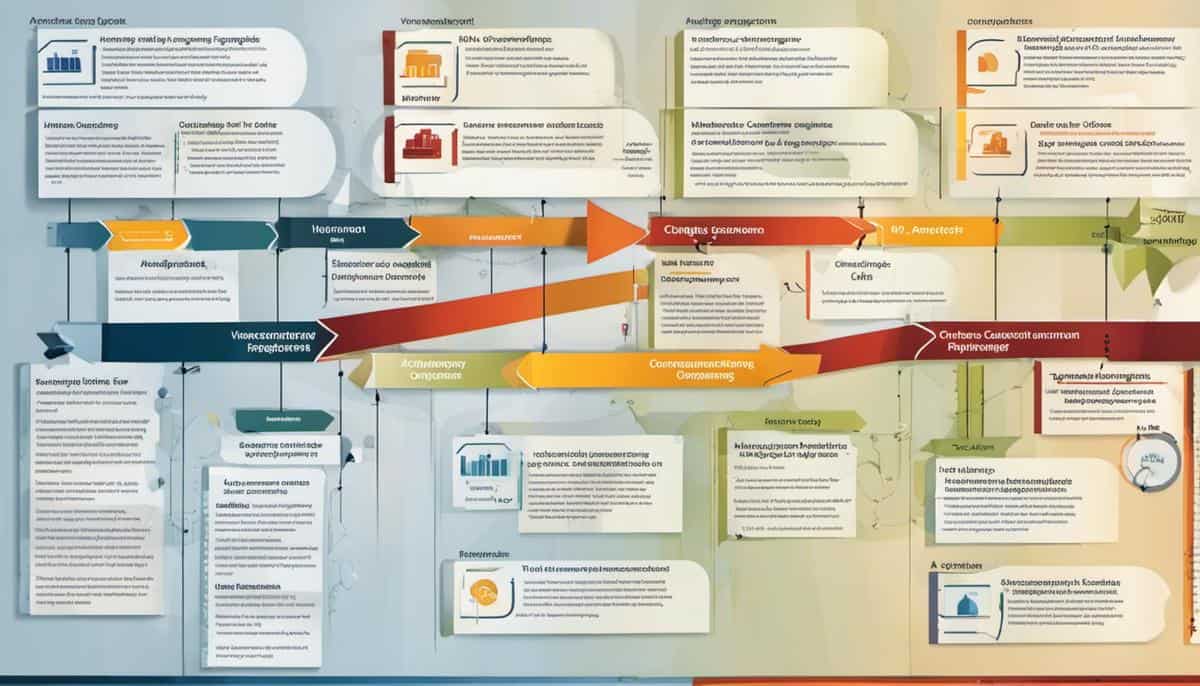The dynamic nature of today’s business environment demands continual evolution to stay competitive.
Change is often the catalyst for this evolution, but it must be effectively managed to yield positive results.
Change Management serves as a proactive approach towards this compass, a paradigm that supports organizations during critical transformations. It is an essential business strategy designed to manage this transition while maintaining productivity and stability. With a strong focus on the human element,
Change Management aids organizations in embracing change, rather than resisting it. Through this process, organizations can make more informed decisions and are better prepared to handle the complexities that come with change.
Understanding the concept of Change Management
Understanding the Concept of Change Management
Change management refers to a systematic approach that is implemented when an organization wishes to transition from a current state to a desired future state. It is a fundamental aspect of business operations, steering the direction in which an organization’s routines, culture, and values shift. Its goal is to facilitate the application of a set of practices or principles to control the effect of change, maximize the organization’s collective benefits while minimizing resistance from its employees.
Relevance of Change Management
In the rapidly changing business world, organizations must cope with internal and external factors like technological advancement, competition, and market change. Change management allows organizations to adapt, survive, and grow in this dynamic business environment. It aids corporations in managing risk, outlasting competition, curbing costs, and generally improving business performance.
Fundamental Principles of Change Management
Change management operates on several guiding principles. Effective communication is a crucial element as it bridges the gap between change leadership and employees. Also, employee involvement and engagement play vital roles in successful change management since they promote ownership and responsibility. Other guiding principles include providing comprehensive change support, maintaining a clear vision for change, and strategic planning and execution. All these principles collectively ensure that change creates value and positively impacts organizational performance.
The Role of Change Management in Organizational Performance
Change management has a substantial contribution to organizational performance. Its primary function is to align the organization’s processes, systems, and employees with the overall strategic objective to boost performance. It aids in anticipating and preparing for the implications of change, mitigating potential adversities, and bolstering the company’s resilience against unexpected threats.
Moreover, change management facilitates the acquisition of new skills, technologies, and methods which are vital in enhancing individual and corporate performance. Through change management, organizations can respond to changes in the market, tackle challenges competently, and seize new opportunities, leading to sustainable success and improved performance.
Change Management Performance
Change management performance involves evaluating an organization’s ability to effectively carry out change. A strong emphasis is placed on the implementation process, including how well change efforts align with the strategic goals, how change is communicated and accepted by the stakeholders, and the outcomes outcome. Using performance metrics, organizations can gain valuable insights into implementation success, areas of improvement, and the overall impact on organizational performance. High-performing change management teams typically demonstrate increased strategic flexibility, responsiveness, and improved overall business results.
Remaining competitive and sustainable in the evolving business landscape requires a vital understanding of change management. With the increasing competition in the market, effective change management practices are ever crucial to ensure the success and sustainability of an organization.

Key elements of a successful Change Management
An Overview of Change Management
Change management is defined as a structured methodology for managing the transition or transformation of a company’s objectives, core principles, operations, or technologies. It primarily centers on implementing strategies to instigate change, manage it effectively, and assist individuals in adapting to the change. Multiple elements must work together coherently for successful change management. These elements encompass effective communication, commitment from leadership, appropriate training and development, provision of incentives, and adequate monitoring and evaluation.
The Critical Role of Communication
In any change management process, communication plays an essential role. It’s the primary tool for expressing the need for change, the benefits of change, and for guiding employees through the stages of change. Effective communication ensures that everyone is on the same page and understands the direction of the planned change. Typically, a communication plan should be developed to structure how and when messages will be delivered to stakeholders. The plan should also detail the channels of communication to be used throughout the change process.
Leadership Commitment
The commitment and involvement of leadership are vital in the change management process. Leaders are responsible for paving the way for change, and their support can significantly determine the success of the change initiative. They are tasked with setting the strategic direction, encouraging staff, allocating resources, and dealing with resistance to change. Leadership commitment also reduces uncertainty and increases the likelihood of the change being accepted and implemented successfully.
Incorporation of Training and Development
Change often involves new ways of doing things. This is where training and development come in – it equips employees with the necessary skills and knowledge to adapt to the new processes, tools, or systems. The type and extent of training required will depend on the nature of the change. Training allows organizations to ensure that employees are not left struggling to fit into the new changes, thereby increasing the chances of successful transition.
Importance of Incentives
Incentives can be useful in motivating employees to embrace change. These can range from financial bonuses, promotions, recognition, or any other benefits that employees value. Incentives can increase staff commitment to the change process, improve morale, and cultivate a positive attitude towards the change.
Monitoring and Measurement: A Vital Tool
Finally, monitoring and measurement are crucial in evaluating the effectiveness of the change management process. This involves setting benchmarks, collecting data, and analyzing the data to evaluate performance.
Monitoring can identify gaps, reveal whether the change is delivering the expected benefits, and helps in making necessary adjustments. This helps ensure the change process stays on track and achieves its objectives.
Implementing change successfully in an organization requires the astute integration of several components. When these elements are married together harmoniously, transitions feel smoother, individual experiences become more enriching, and ultimately, the workings of the operation exhibit increased effectiveness and efficiency.

The Impact of Change Management on Performance
Impact of Change Management on Employee Productivity
Change management, when masterfully executed, can notably enhance employee productivity. In contrast, mishandling change can spawn confusion and resistance, curbing productivity, and fostering an atmosphere of uncertainty.
This can deplete morale and motivation. Conversely, well-strategized change management facilitates employee engagement with the transformation, cultivating motivation and commitment to the organization’s updated trajectory.
Furthermore, when organizations stand as pillars of support for their employees during these periods of shifts, they can promptly steer them toward accepting and aligning with the change, eventually restoring the full productivity speed.
Customer Satisfaction and Change Management
Change management also has a direct impact on customer satisfaction. When change leads to improvements in products, services, or customer interactions, customers often respond positively. Even changes that aren’t directly involved with customers – such as a new internal process or system – can indirectly improve customer satisfaction by enhancing efficiency or effectiveness in the organization. Furthermore, effective change management can minimize disruptions in customer service, as employees are prepared for the change and can better manage potential challenges or issues.
Change Management and Financial Performance
The effect of change management on financial performance is another critical aspect. The cost of poorly managed change can be enormous, leading to wasted resources, decreased productivity, and lost opportunities. On the other hand, an effective change management process can lead to cost savings, increased sales, and other financial benefits. For example, strategic changes can open new markets, create new revenue streams, or improve the efficiency of operations. Similarly, operational changes can reduce costs, increase productivity, or improve the quality of products or services.
Understanding the Impact of Change Management on Business Growth
Change management is a crucial element in the development and prosperity of a company. Businesses that effectively harness the power of change often have an edge in responding to market trends, tackling challenges head-on, and seizing potential opportunities.
These enterprises typically have more committed and efficient staff, greater customer satisfaction, and superior financial outcomes. In the rapidly evolving business world we see today, the skill of managing change successfully is not just a beneficial trait; it’s a necessity.
By utilizing effective change management, a firm can successfully traverse the business landscape, capitalize on emerging opportunities, reduce potential risks, and ultimately drive improved performance and expansion.
Case Studies of Successful Change Management
Case in Point: The Transformation of Ford Motor Company
Ford Motor Company, a renowned automobile manufacturer, experienced a challenging period in the early 2000s.
The company was losing its market share due to the poor quality of its vehicles affecting its brand image. To counteract this downturn, Ford introduced an audacious change management strategy named “The Way Forward”.
This strategy required them to critically assess all operational aspects and commit to challenging changes, such as shutting down factories and reducing workforce.
Although the process was rife with challenges, causing strained negotiations with labor unions and a significant reduction in workforce – a move that impacted morale and invited public scrutiny, the end result was a leaner, more competent organization.
The strategy allowed Ford to prioritize quality over quantity, leading to a significant transformation in the company’s performance. This improvement became evident when Ford outpaced General Motors to become the dominant auto manufacturer in the U.S. for the first time in 56 years.
Case Study: British Airways
During the 1980s, British Airways was experiencing a deteriorating brand image and poor profitability.
The organization hired a new CEO, Colin Marshall, who spearheaded a massive change management initiative. Marhsall believed that an aggressive change in company culture was the key for the turnaround.
He initiated a staff training program which was designed to develop a customer-driven approach, re-framed internal communication to foster a culture of transparency and directly tackled the public image problem.
The execution was not without hurdles. Many employees resisted the change making the process difficult.
However, dedication to the cause paid off. British Airways overcame the initial resistance and emerged triumely, transforming into one of the most profitable airlines in the world within a span of few years.
Case Study: Nokia
Once a global leader in mobile phones, Nokia faced a decline in the late 2000s due to the rising popularity of smartphones from competitors like Apple and Samsung.
Nokia’s decision to hold onto Symbian operating system instead of switching to Android or developing its own competitive software was seen as a major strategic failure.
In 2011, with appointed CEO Stephen Elop, Nokia announced a strategic alliance with Microsoft to collaborate on the Windows Phone. This required immense structural changes, something that’s epicentrically difficult for a technology-based company as Nokia.
There were grave concerns about the partnership’s potential but to everyone’s surprise, Nokia pulled off the transformation.
The collaboration resulted in Nokia’s Lumia range which helped restore Nokia’s name in the smartphone segment for a certain period.
This case study emphasizes the importance of making difficult strategic decisions and embracing change in a rapidly evolving market.
Case Study: IBM
IBM, the multinational technology company, had to undergo a dramatic shift in the 1990s. Faced with financial losses, it needed to transform its business model from predominantly hardware to a broad-based information technology and services company.
The transformation was led by a newly appointed CEO, Lou Gerstner, who initiated massive layoffs, discontinued unprofitable product lines and altered the company’s business direction. While such a grand-scale transition was not easy, and triggered initial resistance, IBM successfully transitioned into the services business.
Today, IBM’s Global Services contributes to a major chunk of its total revenues, demonstrating how an organization can successfully navigate change, regardless of its scale.
In a variety of case studies, it was found that implementation and management of change brought significant challenges to organizations.
From these studies, it was also observed that effective strategies, careful planning, and focused leadership became the key factors in overcoming these hurdles. The successful navigation of these challenges resulted in improved performance across board.

What Strategies Can Help Navigate Change Management for Optimal Performance?
When it comes to achieving optimal performance during transitions, implementing effective change management tips smooth transitions. Strategies such as clear communication, involving employees in decision-making, and providing support and training can help navigate change management for the best outcomes.
Essential Practices for Ensuring Change Management Performance
Resistance to Change: How to Manage It
The achievement of optimal performance in change management is often tied to proficiently handling resistance.
Resistance typically stems from fears associated with change – such as the unknown, potential job insecurity and the struggle in letting go of familiar routines and behaviours. However, recognizing and addressing this resistance in advance facilitates smoother transitions.
This is possible when change managers involve stakeholders early in the process and maintain full transparency about the reasons for change.
By giving stakeholders a sense of involvement and ownership over changes to be implemented and providing support through empathetic communication, resistance can be diminished and managed more effectively.
Building a Change-Ready Culture
Creating a change-ready culture is another essential practice for change management performance. This entails fostering a corporate culture that is open to change and innovation. It involves developing agile leaders who inspire their teams and steer them through the change process smoothly. Training employees to be change agents and promoting a mindset that embraces learning and adaptability can significantly contribute to building a change-ready culture.
Foster Continuous Communication
Open and continuous communication is a crucial practice in executing change management. Change leaders should communicate clearly and frequently about the upcoming changes, the reasons behind them, and the potential benefits. This helps dispel any rumors or misinformation that could cause unnecessary alarm among employees. It’s also important to maintain two-way communication channels where employees can voice their concerns and provide their input.
Promote Flexible Adaptation
Strategic change management requires promoting flexible adaptation to changes. This involves developing strategic plans that are adaptable to evolving circumstances and unexpected challenges. By allowing some flexibility in the execution of the change process, organizations can better react to unforeseen circumstances, incorporate learnings, and adjust their strategies accordingly.
Strategic Actions in Change Management
Other strategic actions in change management encompass understanding the organization’s readiness for change, setting clear objectives for change initiatives, allocating sufficient resources, and monitoring and evaluating the change process regularly.
Equally important is to recognize and appreciate the efforts and successes of individuals and teams during the change process. Rewards and recognition for the adoption of new behaviors and successfully achieving change milestones can foster a feeling of ownership and commitment among employees.
This blend of carefully managing resistance, building a flexible and open culture, fostering clear communication, and being adaptable forms the bedrock of successful change management performance. These are essential practices for executing change management and ensuring optimal results in an ever-evolving business environment.

Change Management, when appropriately implemented and executed, can become a powerful tool for shaping the future of any organization regardless of its size or industry.
It drives a culture of transparency, engagement, and continuous improvement. Various practices such as consistent communication, training and development, managing resistance, and creating a change-ready culture contribute to successful Change Management implementation.
It is through these practices organizations can turn potential disruptions into opportunities for growth and improvement.
Hence, as we move forward in this era of incessant change, adopting proficient Change Management practices becomes an indispensable element for not only surviving but thriving in the global market.





